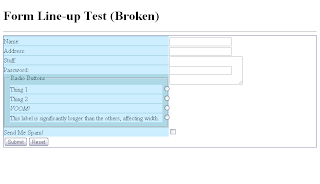Several years ago, when I first decided I needed a blog, I decided to try an experiment: I’d sign up for both Wordpress and Blogger and use both in parallel for a while to see which one I liked better. Eventually, had things gone according to plan, I would have written a post comparing and contrasting the two services. At that point I would have picked whichever one I liked the most, imported all the posts and comments from the loser to the winner, and stuck with a single platform from then on.
Part of the reason that failed was that I just didn’t blog that often. I’ve managed roughly one post every month since May of 2012, but before that, I just didn’t blog enough to be getting useful data about what I liked and didn’t like about each platform. The experiment, if I’d been intent on doing it right, would have required me to produce a lot of content. In reality, though, I generally avoided writing unless I had something I really wanted to get off my chest.
Of course, I did eventually start blogging more or less regularly, so that can’t be the only reason. I can think of a few others.
The primary reason is that I tried to keep similar posts on the same blog. If I wrote a follow-up post, it went on the same blog as the earlier post that inspired it. If I wrote several posts that shared a category, they went on the same blog, so people looking at the category could actually see the whole category, and not miss half of it because they didn’t know they needed to search two different blogs. This tactic, combined with the fact that I don’t write about too many different topics, resulted in my sticking mainly with Wordpress.
This caused a couple of secondary effects. First, when people started finding my posts and following them, it was on the blog where most of the posts actually were. Second, since I was using Wordpress more than Blogger, I wound up getting used to it and became more comfortable with it. These days, on the rare occasions when I log into Blogger, I feel just a bit out of place.
Of course, it isn’t entirely by accident that I went with Wordpress. There are some ways I prefer it over Blogger.
Probably the biggest one is—or was—Blogger’s unfortunate habit of translating paragraph breaks to pairs of line breaks. I could use the <p> tag all I wanted in the editor’s HTML view, but Blogger would strip it out and replace it with <br /><br />. I can be a bit picky about using the right HTML element for the right job, so this was a big annoyance. I just tested it, though, and apparently this is no longer the case. If this change had occurred before I got used to Wordpress, things might have turned out differently. On the other hand, even now it seems to have replaced my <p>s with single <br />s, but that may be a quirk of the WYSIWYG editor. Either way I don't feel like dealing with it.
I also like that Wordpress has syntax highlighting for source code built-in. It’s possible to add it to blogger, but it takes some up-front work and using it isn’t as elegant. (I normally don’t mind a little up-front work, but not if I can get the same or better results without it.)
One more little thing I like about Wordpesss is that it lets me organize posts into categories and subcategories, whereas Blogger only has tags. I don’t really see the need for Wordpress to have categories and tags, but on the other hand it’s nice to have the options.
That’s not to say that Blogger doesn’t have its advantages. For one thing, it’s a lot more customizable. It only has a handful of templates, compared to the hundreds Wordpress has, but there’s a great deal that can be done to customize a Blogger template. Blogger even allows for the addition of custom HTML and CSS to the templates, and it doesn’t charge for it. (As far as I can tell, Wordpress.com charges a fee for custom CSS and doesn’t allow custom HTML at all.)
I also appreciated that Blogger’s HTML view showed me the actual HTML, or at least something a bit closer than Wordpress did. Even though Blogger used to modify my paragraph breaks, it would at least show me the resulting <br /> tags. Wordpress, on the other hand, replaced my <p> tags with a pair of line breaks in the editor, but in the actual post they’d still show up as p elements.
There’s also the fact that Blogger is owned by Google and uses the same unified Gmail/Google+ account used by all Google services. Whether that’s a point in favor of Blogger or against it will depend on your opinion of Google, but there’s something to be said for not having to manage yet another username and password.
I suppose this will have to suffice for that comparison post I said I was going to write.
As for the future of this blog, I’ve decided to bite the bullet and move everything over to Wordpress.com. I’m importing all the posts and comments (or lack thereof) from Blogger to Wordpress. I’ll also be removing the “My other blog” widget from Wordpress and renaming the one on Blogger to indicate that Wordpress is where all the current content is. Once I’m finished, Wordpress will be (for the time being, at least) the canonical home of this blog.

